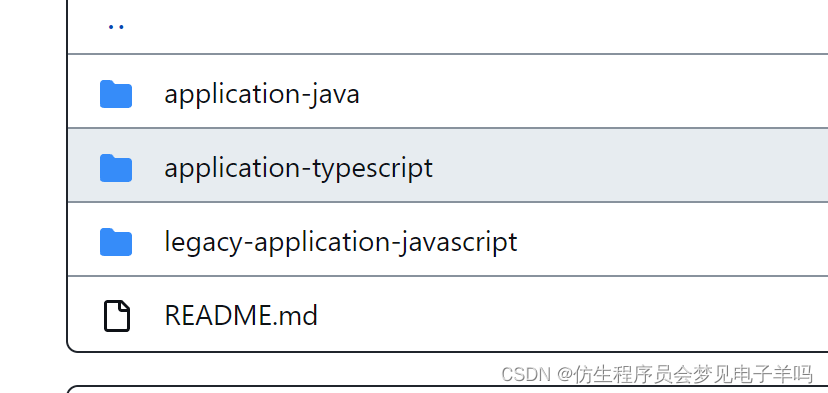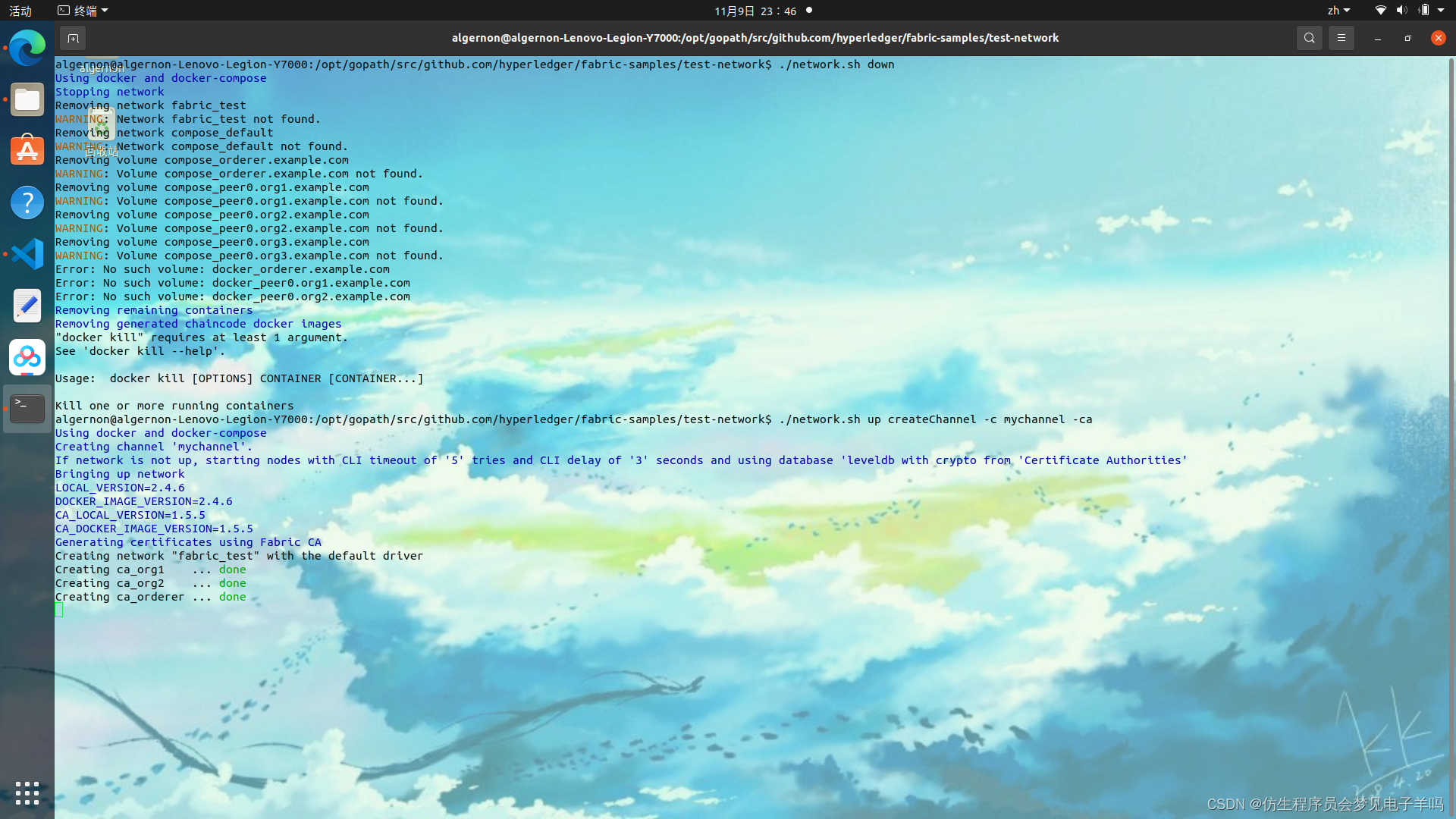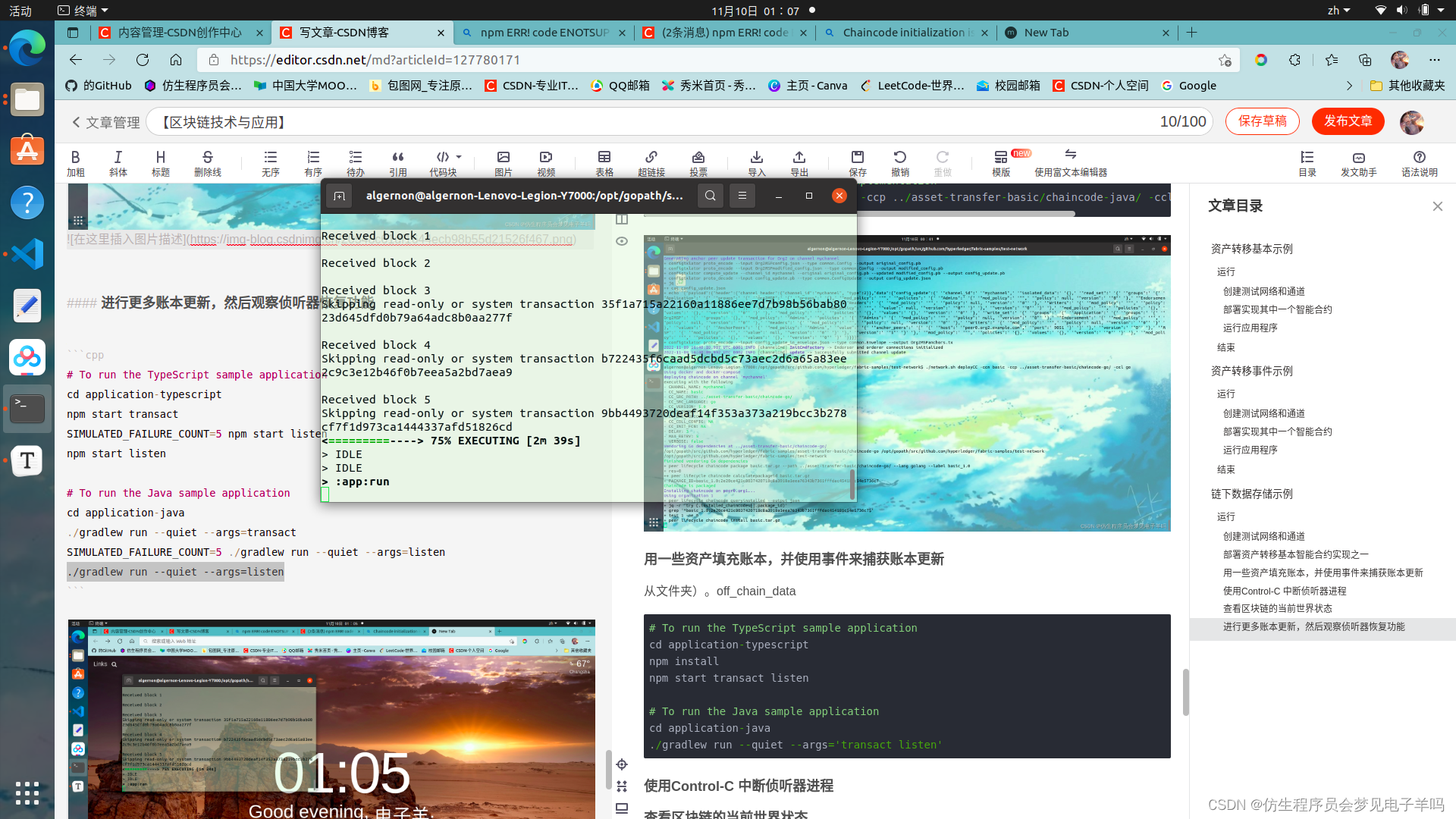
引言
本次任务相对顺利,因为是已经打包的案例。不过二三案例中不像案例一中有go的chaincode,执行需要花时间debug

案例链接:
https://pkg.go.dev/github.com/hyperledger/fabric-gateway/pkg/client#section-readme
案例一:资产转移基本示例
代码分析
资产转移基本示例演示:
- 将客户端应用程序连接到 Fabric 区块链网络。
- 提交智能合约交易以更新账本状态。
- 评估智能合约交易以查询账本状态。
- 处理事务调用中的错误。
https://blog.csdn.net/ling1998/article/details/127202209
链码启动
项目地址:
https://github.com/hyperledger/fabric-samples/blob/main/asset-transfer-basic/chaincode-go/assetTransfer.go
/*
SPDX-License-Identifier: Apache-2.0
*/
package main
import (
"log"
"github.com/hyperledger/fabric-contract-api-go/contractapi"
"github.com/hyperledger/fabric-samples/asset-transfer-basic/chaincode-go/chaincode"
)
func main() {
assetChaincode, err := contractapi.NewChaincode(&chaincode.SmartContract{})
if err != nil {
log.Panicf("Error creating asset-transfer-basic chaincode: %v", err)
}
if err := assetChaincode.Start(); err != nil {
log.Panicf("Error starting asset-transfer-basic chaincode: %v", err)
}
}
- 1
- 2
- 3
- 4
- 5
- 6
- 7
- 8
- 9
- 10
- 11
- 12
- 13
- 14
- 15
- 16
- 17
- 18
- 19
- 20
- 21
- 22
- 23
链码结构
asset-transfer-basic/chaincode-go/chaincode/smartcontract.go
type SmartContract struct {
contractapi.Contract
}
- 1
- 2
- 3
完整代码
package chaincode
import (
"encoding/json"
"fmt"
"github.com/hyperledger/fabric-contract-api-go/contractapi"
)
// SmartContract provides functions for managing an Asset
type SmartContract struct {
contractapi.Contract
}
// Asset describes basic details of what makes up a simple asset
//Insert struct field in alphabetic order => to achieve determinism across languages
// golang keeps the order when marshal to json but doesn't order automatically
type Asset struct {
AppraisedValue int `json:"AppraisedValue"`
Color string `json:"Color"`
ID string `json:"ID"`
Owner string `json:"Owner"`
Size int `json:"Size"`
}
// InitLedger adds a base set of assets to the ledger
func (s *SmartContract) InitLedger(ctx contractapi.TransactionContextInterface) error {
assets := []Asset{
{ID: "asset1", Color: "blue", Size: 5, Owner: "Tomoko", AppraisedValue: 300},
{ID: "asset2", Color: "red", Size: 5, Owner: "Brad", AppraisedValue: 400},
{ID: "asset3", Color: "green", Size: 10, Owner: "Jin Soo", AppraisedValue: 500},
{ID: "asset4", Color: "yellow", Size: 10, Owner: "Max", AppraisedValue: 600},
{ID: "asset5", Color: "black", Size: 15, Owner: "Adriana", AppraisedValue: 700},
{ID: "asset6", Color: "white", Size: 15, Owner: "Michel", AppraisedValue: 800},
}
for _, asset := range assets {
assetJSON, err := json.Marshal(asset)
if err != nil {
return err
}
err = ctx.GetStub().PutState(asset.ID, assetJSON)
if err != nil {
return fmt.Errorf("failed to put to world state. %v", err)
}
}
return nil
}
// CreateAsset issues a new asset to the world state with given details.
func (s *SmartContract) CreateAsset(ctx contractapi.TransactionContextInterface, id string, color string, size int, owner string, appraisedValue int) error {
exists, err := s.AssetExists(ctx, id)
if err != nil {
return err
}
if exists {
return fmt.Errorf("the asset %s already exists", id)
}
asset := Asset{
ID: id,
Color: color,
Size: size,
Owner: owner,
AppraisedValue: appraisedValue,
}
assetJSON, err := json.Marshal(asset)
if err != nil {
return err
}
return ctx.GetStub().PutState(id, assetJSON)
}
// ReadAsset returns the asset stored in the world state with given id.
func (s *SmartContract) ReadAsset(ctx contractapi.TransactionContextInterface, id string) (*Asset, error) {
assetJSON, err := ctx.GetStub().GetState(id)
if err != nil {
return nil, fmt.Errorf("failed to read from world state: %v", err)
}
if assetJSON == nil {
return nil, fmt.Errorf("the asset %s does not exist", id)
}
var asset Asset
err = json.Unmarshal(assetJSON, &asset)
if err != nil {
return nil, err
}
return &asset, nil
}
// UpdateAsset updates an existing asset in the world state with provided parameters.
func (s *SmartContract) UpdateAsset(ctx contractapi.TransactionContextInterface, id string, color string, size int, owner string, appraisedValue int) error {
exists, err := s.AssetExists(ctx, id)
if err != nil {
return err
}
if !exists {
return fmt.Errorf("the asset %s does not exist", id)
}
// overwriting original asset with new asset
asset := Asset{
ID: id,
Color: color,
Size: size,
Owner: owner,
AppraisedValue: appraisedValue,
}
assetJSON, err := json.Marshal(asset)
if err != nil {
return err
}
return ctx.GetStub().PutState(id, assetJSON)
}
// DeleteAsset deletes an given asset from the world state.
func (s *SmartContract) DeleteAsset(ctx contractapi.TransactionContextInterface, id string) error {
exists, err := s.AssetExists(ctx, id)
if err != nil {
return err
}
if !exists {
return fmt.Errorf("the asset %s does not exist", id)
}
return ctx.GetStub().DelState(id)
}
// AssetExists returns true when asset with given ID exists in world state
func (s *SmartContract) AssetExists(ctx contractapi.TransactionContextInterface, id string) (bool, error) {
assetJSON, err := ctx.GetStub().GetState(id)
if err != nil {
return false, fmt.Errorf("failed to read from world state: %v", err)
}
return assetJSON != nil, nil
}
// TransferAsset updates the owner field of asset with given id in world state, and returns the old owner.
func (s *SmartContract) TransferAsset(ctx contractapi.TransactionContextInterface, id string, newOwner string) (string, error) {
asset, err := s.ReadAsset(ctx, id)
if err != nil {
return "", err
}
oldOwner := asset.Owner
asset.Owner = newOwner
assetJSON, err := json.Marshal(asset)
if err != nil {
return "", err
}
err = ctx.GetStub().PutState(id, assetJSON)
if err != nil {
return "", err
}
return oldOwner, nil
}
// GetAllAssets returns all assets found in world state
func (s *SmartContract) GetAllAssets(ctx contractapi.TransactionContextInterface) ([]*Asset, error) {
// range query with empty string for startKey and endKey does an
// open-ended query of all assets in the chaincode namespace.
resultsIterator, err := ctx.GetStub().GetStateByRange("", "")
if err != nil {
return nil, err
}
defer resultsIterator.Close()
var assets []*Asset
for resultsIterator.HasNext() {
queryResponse, err := resultsIterator.Next()
if err != nil {
return nil, err
}
var asset Asset
err = json.Unmarshal(queryResponse.Value, &asset)
if err != nil {
return nil, err
}
assets = append(assets, &asset)
}
return assets, nil
}
- 1
- 2
- 3
- 4
- 5
- 6
- 7
- 8
- 9
- 10
- 11
- 12
- 13
- 14
- 15
- 16
- 17
- 18
- 19
- 20
- 21
- 22
- 23
- 24
- 25
- 26
- 27
- 28
- 29
- 30
- 31
- 32
- 33
- 34
- 35
- 36
- 37
- 38
- 39
- 40
- 41
- 42
- 43
- 44
- 45
- 46
- 47
- 48
- 49
- 50
- 51
- 52
- 53
- 54
- 55
- 56
- 57
- 58
- 59
- 60
- 61
- 62
- 63
- 64
- 65
- 66
- 67
- 68
- 69
- 70
- 71
- 72
- 73
- 74
- 75
- 76
- 77
- 78
- 79
- 80
- 81
- 82
- 83
- 84
- 85
- 86
- 87
- 88
- 89
- 90
- 91
- 92
- 93
- 94
- 95
- 96
- 97
- 98
- 99
- 100
- 101
- 102
- 103
- 104
- 105
- 106
- 107
- 108
- 109
- 110
- 111
- 112
- 113
- 114
- 115
- 116
- 117
- 118
- 119
- 120
- 121
- 122
- 123
- 124
- 125
- 126
- 127
- 128
- 129
- 130
- 131
- 132
- 133
- 134
- 135
- 136
- 137
- 138
- 139
- 140
- 141
- 142
- 143
- 144
- 145
- 146
- 147
- 148
- 149
- 150
- 151
- 152
- 153
- 154
- 155
- 156
- 157
- 158
- 159
- 160
- 161
- 162
- 163
- 164
- 165
- 166
- 167
- 168
- 169
- 170
- 171
- 172
- 173
- 174
- 175
- 176
- 177
- 178
- 179
- 180
- 181
- 182
- 183
- 184
- 185
- 186
- 187
- 188
- 189
- 190
- 191
- 192
- 193
- 194
运行
创建测试网络和通道
./network.sh up createChannel -c mychannel -ca
- 1


部署实现其中一个智能合约
# To deploy the TypeScript chaincode implementation
./network.sh deployCC -ccn basic -ccp ../asset-transfer-basic/chaincode-typescript/ -ccl typescript
# To deploy the Go chaincode implementation
./network.sh deployCC -ccn basic -ccp ../asset-transfer-basic/chaincode-go/ -ccl go
# To deploy the Java chaincode implementation
./network.sh deployCC -ccn basic -ccp ../asset-transfer-basic/chaincode-java/ -ccl java
- 1
- 2
- 3
- 4
- 5
- 6
- 7
- 8




运行应用程序
# To run the Typescript sample application
cd application-gateway-typescript
npm install
npm start
# To run the Go sample application
cd application-gateway-go
go run .
# To run the Java sample application
cd application-gateway-java
./gradlew run
- 1
- 2
- 3
- 4
- 5
- 6
- 7
- 8
- 9
- 10
- 11
- 12


结束
./network.sh down
- 1
案例二:资产转移事件示例
资产转移事件示例演示:
从智能合约交易函数发出链码事件。
在客户端应用程序中接收链码事件。
在客户端应用程序中重放以前的链码事件。
运行
创建测试网络和通道
./network.sh up createChannel -c mychannel -ca
- 1

部署实现其中一个智能合约
# To deploy the JavaScript chaincode implementation
./network.sh deployCC -ccn events -ccp ../asset-transfer-events/chaincode-javascript/ -ccl javascript -ccep "OR('Org1MSP.peer','Org2MSP.peer')"
# To deploy the Java chaincode implementation
./network.sh deployCC -ccn events -ccp ../asset-transfer-events/chaincode-java/ -ccl java -ccep "OR('Org1MSP.peer','Org2MSP.peer')"
- 1
- 2
- 3
- 4
- 5


运行应用程序
(从文件夹)asset-transfer-events
# To run the Go sample application
cd application-gateway-go
go run .
# To run the Typescript sample application
cd application-gateway-typescript
npm install
npm start
# To run the Java sample application
cd application-gateway-java
./gradlew run
- 1
- 2
- 3
- 4
- 5
- 6
- 7
- 8
- 9
- 10
- 11
- 12

结束
回到test-network
./network.sh down
- 1
案例三:链下数据存储示例
链下数据存储示例演示:
- 在客户端应用程序中接收块事件。
- 使用检查指针在发生故障或应用程序重新启动后恢复事件侦听。
- 从区块事件中提取账本更新,以构建链下数据存储。
运行
创建测试网络和通道
./network.sh up createChannel -c mychannel -ca
- 1


部署资产转移基本智能合约实现之一
# To deploy the TypeScript chaincode implementation
./network.sh deployCC -ccn basic -ccp ../asset-transfer-basic/chaincode-typescript/ -ccl typescript
# To deploy the Go chaincode implementation
./network.sh deployCC -ccn basic -ccp ../asset-transfer-basic/chaincode-go/ -ccl go
# To deploy the Java chaincode implementation
./network.sh deployCC -ccn basic -ccp ../asset-transfer-basic/chaincode-java/ -ccl java
- 1
- 2
- 3
- 4
- 5
- 6
- 7
- 8

用一些资产填充账本,并使用事件来捕获账本更新
从文件夹)。off_chain_data
# To run the TypeScript sample application
cd application-typescript
npm install
npm start transact listen
# To run the Java sample application
cd application-java
./gradlew run --quiet --args='transact listen'
- 1
- 2
- 3
- 4
- 5
- 6
- 7
- 8
使用Control-C 中断侦听器进程
查看区块链的当前世界状态
off_chain_datastore.log
# To run the TypeScript sample application
cd application-typescript
npm --silent start getAllAssets
# To run the Java sample application
cd application-java
./gradlew run --quiet --args=getAllAssets
- 1
- 2
- 3
- 4
- 5
- 6
- 7

进行更多账本更新,然后观察侦听器恢复功能
# To run the TypeScript sample application
cd application-typescript
npm start transact
SIMULATED_FAILURE_COUNT=5 npm start listen
npm start listen
# To run the Java sample application
cd application-java
./gradlew run --quiet --args=transact
SIMULATED_FAILURE_COUNT=5 ./gradlew run --quiet --args=listen
./gradlew run --quiet --args=listen
- 1
- 2
- 3
- 4
- 5
- 6
- 7
- 8
- 9
- 10
- 11


总结
本周主要进行了三个案例的实战,跑代码很顺利所以心情也很好。
需要注意的一点是,案例中同时给出了java和go的代码,第一次把两个都跑了,事实上只需要选择一个就可。
建议还是用go。

第一部分的资产转移案例还有拓展内容,可以作为参考
https://blog.csdn.net/ling1998/article/details/127202209


评论记录:
回复评论: